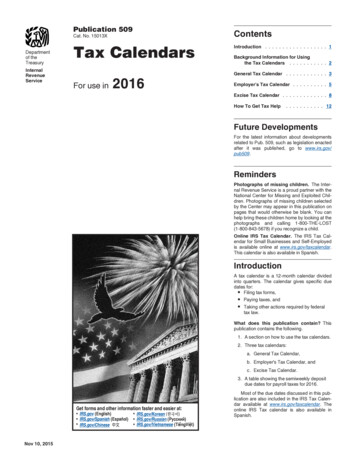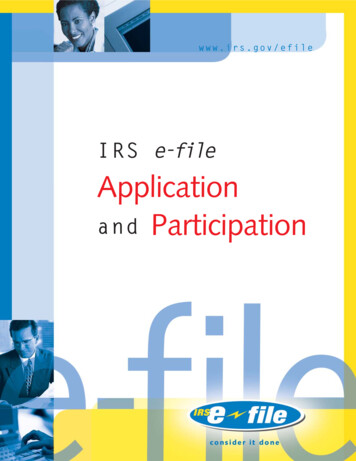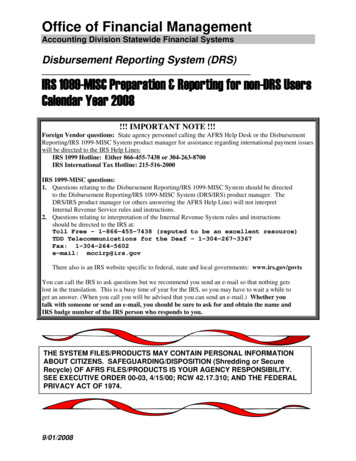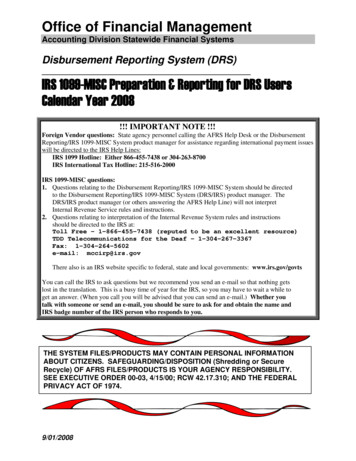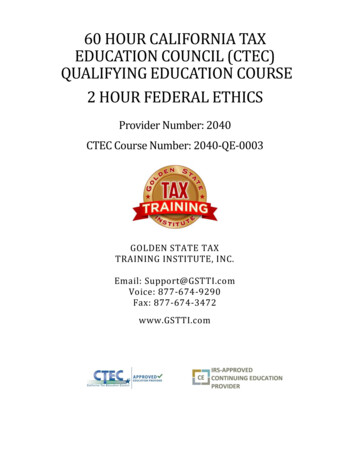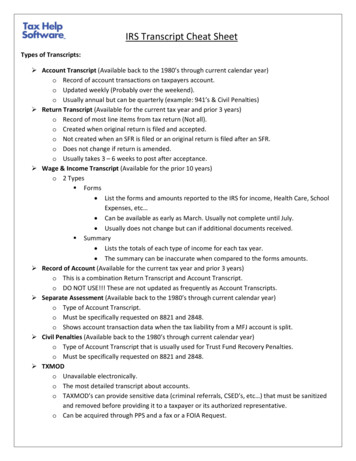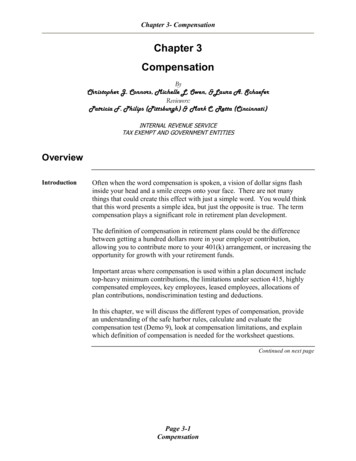
Transcription
Chapter 3- CompensationChapter 3CompensationByChristopher J. Connors, Michelle L. Owen, &Laura A. SchaeferReviewers:Patricia F. Philips (Pittsburgh) & Mark C. Retta (Cincinnati)INTERNAL REVENUE SERVICETAX EXEMPT AND GOVERNMENT ENTITIESOverviewIntroductionOften when the word compensation is spoken, a vision of dollar signs flashinside your head and a smile creeps onto your face. There are not manythings that could create this effect with just a simple word. You would thinkthat this word presents a simple idea, but just the opposite is true. The termcompensation plays a significant role in retirement plan development.The definition of compensation in retirement plans could be the differencebetween getting a hundred dollars more in your employer contribution,allowing you to contribute more to your 401(k) arrangement, or increasing theopportunity for growth with your retirement funds.Important areas where compensation is used within a plan document includetop-heavy minimum contributions, the limitations under section 415, highlycompensated employees, key employees, leased employees, allocations ofplan contributions, nondiscrimination testing and deductions.In this chapter, we will discuss the different types of compensation, providean understanding of the safe harbor rules, calculate and evaluate thecompensation test (Demo 9), look at compensation limitations, and explainwhich definition of compensation is needed for the worksheet questions.Continued on next pagePage 3-1Compensation
Chapter 3- CompensationOverview, ContinuedIn ThisChapterThis chapter contains the following topics:OVERVIEW --------------------1SECTION 415 COMPENSATION ORY SAFE HARBOR RULES UNDER SECTION 415 -----7ALTERNATIVE SAFE HARBOR DEFINITIONS UNDER 1.415-2(D)(11) ---------------------------------------- 10W-2 SAFE HARBOR (1.415-2(D)(11)(I) ---------------------------------- 11WITHHOLDING SAFE HARBOR (SECTION -------------------- 11SAFE HARBOR EXAMPLES UNDER SECTION ------------------- 12KEY SIMILARITIES BETWEEN THE 415 DEFINITIONS -------- 13IMPORTANT AREAS 415 COMPENSATION MUST BE USED -- 14MISCELLANEOUS ITEMS FOR SECTION 415 COMPENSATION ----------------------------------------------- 16IRC SECTION 414(S) COMPENSATION ------------------------------- 17ALTERNATIVE SAFE HARBOR 414(S) DEFINITION ------------- 21REASONABLE DEFINITION OF ---------------------------- 24REASONABLE DEFINITION OF COMPENSATION-DEMO 9 --- 26CALCULATION OF THE DEMO ---------------------------------------- 27PRIOR EMPLOYER & IMPUTED COMPENSATION -------------- 36COMPENSATION FOR ACCRUED BENEFITS ---------------------- 37COMPENSATION LIMITATION ----------------------------------------- 39COMPENSATION LIMITATION TABLE ------------------------------ 42COMPENSATION WORKSHEET QUESTIONS ---------------------- 43SUMMARY ------------------- 45EXERCISES ------------------ 46Page 3-2Compensation
Chapter 3- CompensationSection 415 CompensationOverview ofcompensationCompensation must be defined in a plan for many purposes. Each plancomponent can use a different definition of “compensation.” Therefore, asingle plan may define compensation several ways.Compensation may be used to determine the amount of benefits accrued in adefined benefit plan or the amount of contributions allocated to accounts for adefined contribution plan.In addition to calculating the amount of benefits, Section 415 compensationalso places limits on the amount of benefits or allocations. When a mandatorytop heavy benefit arises, compensation is used to determine the amount of thetop heavy benefit. Compensation is also a factor when testing the plan for nondiscrimination.Finally, compensation is used by the employer when figuring out thededuction limits under IRC Section 404.Because the definition of compensation has so many plan applications, it isimportant to be able to define and distinguish the requirements forcompensation for various plan purposes.Four Section415CompensationDefinitionsIn order to comply with the Compensation limits specified under Section 415of the Internal Revenue Code, it is necessary for a qualified plan to accuratelydescribe which definition of Compensation the plan will be using to adhere tothese limits.Generally, there are four viable definitions of Compensation used to determineSection 415 Compensation. Under the regulations for IRC 415, there is thestatutory definition and three safe harbor definitions.Continued on next pagePage 3-3Compensation
Chapter 3- CompensationSection 415 Compensation, ContinuedIncorporationby ReferenceWhen a plan uses a definition of compensation that is intended to satisfySection 415(c)(3), the definition must clearly state which acceptable definitionis being used to avoid ambiguity. For example, a reference to Section415(c)(3) is not acceptable because there are four definitions which may beused, and the reference would be unclear as to which definition is meant.When a plan incorporates the Section 415 definitions contained in theregulations, the plan may use specific regulation sections. However, the planmust then also modify the definition to add in the deferrals under Section415(c)(3)(D). At the time of this writing, the deferrals must be listed out.The definition of compensation used for the safe harbor plan associated withthe safe harbor plan must be incorporated by reference.StatutoryDefinitionUnder Section415CompensationRecent LawChanges thatRequireAdditions to theStatutoryDefinition ofCompensationTreas. Reg. Section 1.415-2(d)(2) provides a detailed definition of IRC415(c)(3) compensation which includes all wages, salaries and other amountsreceived that are includible in the employee’s gross income.The regulations under IRC 415 have not been updated since the passage ofSBJPA. Therefore, each definition of compensation under IRC 415 mustinclude the following two categories of items from IRC 415(c)(3)(D):1. Effective for years beginning after December 31, 1997, elective contributions to a Section 457(b) eligible deferredcompensation plan or to a cafeteria plan (Section 125 plan), and elective deferrals as described under IRC Section 402(g)(3). Thisincludes elective deferrals to a 401(k) plan, a Section 403(b) taxshelter annuity plan, a SIMPLE IRA, or a SARSEP, includingcatch-up contributions2. For plan and limitation years beginning on and after January 1, 2001(or, if earlier the date the plan complied in operation, but no earlier thanJanuary 1, 1998), compensation paid or made available during suchplan and limitation years shall include elective amounts for qualifiedtransportation fringe benefits that are not includable in the gross incomeof the employee by reason of IRC section 132(f)(4).Continued on next pagePage 3-4Compensation
Chapter 3- CompensationSection 415 Compensation, ContinuedOtherAcceptableDefinitions ofCompensationThe other three definitions of compensation under IRC 415 are safe harbordefinitions addressed later in this chapter.Items Includedin Treas. Regs.1.415-2(d)(2)Definition ofCompensationItems which are included in compensation for purposes of IRC Section 415under Treas. Reg. 1.415-2(d)(2) are as follows: In the case of a self-employed individual treated as an employee underIRC 401(c)(1), the employee's earned income as described in section401(c)(2) and the regulations there under. Treas. Reg. 1.415-2(d)(2)(ii) Medical or disability benefits as described in IRC Sections 104(a)(3),105(a) and 105(h), but only to the extent that these amounts are includiblein the gross income of the employee. Treas. Reg. 1.415-2(d)(2)(iii) Amounts paid or reimbursed by the employer for moving expensesincurred by an employee, but only to the extent that at the time of thepayment it is reasonable to believe that these amounts are not deductibleby the employee under IRC Section 217. Treas. Reg. 1.415-2(d)(2)(iv) The value of a non-qualified stock option granted to an employee by theemployer, but only to the extent that the value of the option is includible inthe gross income of the employee for the taxable year in which granted.Treas. Reg. 1.415-2(d)(2)(v) The amount includible in the gross income of an employee upon makingthe election described in IRC Section 83(b) with respect to propertyreceived for services rendered. Treas. Reg. 1.415-2(d)(2)(vi)Continued on next pagePage 3-5Compensation
Chapter 3- CompensationSection 415 Compensation, ContinuedItemsExcluded fromTreas. Regs.1.415-2(d)(3)Definition ofCompensationItems which are always required to be excluded from compensation forpurposes of IRC Section 415 limitations under Treas. Reg. 1.415-2(d)(3) areas follows: Contributions made by the employer to deferred compensation plans to theextent that the contributions are not includible in the employee’s grossincome. Distributions from deferred compensation plans. However, any amountsreceived by an employee pursuant to an unfunded non-qualified plan arepermitted to be considered as compensation for IRC Section 415 purposesin the year the amounts are includible in the gross income of the employee.Treas. Regs. Section 1.415-2(d)(3)(i). Amounts realized from the exercise of nonqualified stock options Amounts realized from the sale or exchange of stock acquired under aqualified stock option Certain premiums for group-term life insurance.Continued on next pagePage 3-6Compensation
Chapter 3- CompensationStatutory Safe Harbor Rules under Section 415IntroductionThere are three safe harbor definitions. The “statutory safe harbor” and twoalternative safe harbors (below).The “statutory safe harbor” or “traditional safe harbor” is the safe harborcontained in Treas. Regs. 1.415-2(d)(10). Under this rule, any definition ofcompensation which includes the various types of remuneration listed inTreas. Regs. 1.415-2(d)(2)(i). Other types of income that are not included(but are included in other definitions) are 1.415-2(d)(2)(ii-vi) (see below). Inaddition, this definition excludes all of the forms of remuneration listed inTreas. Reg. 1.415-2(d)(3) will automatically meet the requirements of IRC415(c)(3).Included Itemsin Safe HarborCompensationDefinitionTreas. Regs. 1.415-2(d)(2)(i) requires the following items to be included inthe definition of compensation: All wages Salaries Other amounts received that are includible in the employee’s grossincome, including overtime Other items include commissions, fees for professional services, tips,bonuses, fringe benefits and reimbursements or other expense allowancesunder a non-accountable plan as described in Treas. Reg. Section 1.622(c) Compensation also includes foreign earned income without regard to theexclusions under IRC sections 911, 931 and 933Continued on next pagePage 3-7Compensation
Chapter 3- CompensationStatutory Safe Harbor Rules under Section 415, ContinuedItems Excludedfrom StatutoryDefinition tosatisfy safeharborItems listed under Treas. Reg. 1.415-2(d)(2)(ii )-(vi) which would normallybe included in the definition of compensation may be excluded from the safeharbor definition of compensation. The plan must exclude the entire list ornone at all. These items include: In the case of self-employed individual considered an employee withinthe meaning of IRC 401(c)(1), the employee's earned income (asdescribed in section 401(c)(2) and the regulations thereunder). Treas.Reg. 1.415-2(d)(2)(ii) Medical or disability benefits as described in IRC Sections 104(a)(3),105(a) and 105(h), but only to the extent that these amounts areincludible in the gross income of the employee. Treas. Reg. 1.4152(d)(2)(iii) Amounts paid or reimbursed by the employer for moving expensesincurred by an employee, but only to the extent that at the time of thepayment it is reasonable to believe that these amounts are not deductibleby the employee under IRC Section 217. Treas. Reg. 1.415-2(d)(2)(iv) The value of a non-qualified stock option granted to an employee by theemployer, but only to the extent that the value of the option is includiblein the gross income of the employee for the taxable year in whichgranted. Treas. Reg. 1.415-2(d)(2)(v) The amount includible in the gross income of an employee upon makingthe election described in IRC Section 83(b) with respect to propertyreceived for services rendered. Treas. Reg. 1.415-2(d)(2)(vi)Continued on next pagePage 3-8Compensation
Chapter 3- CompensationStatutory Safe Harbor Rules under Section 415, ContinuedStatutorychanges to 415compensationare excluded1. Effective for years beginning after December 31, 1997, electivecontributions to a Section 457(b) eligible deferred compensation plan orto a cafeteria plan (Section 125 plan) and elective deferrals as describedunder IRC Section 402(g)(3). This includes elective deferrals to a 401(k)plan, a Section 403(b) tax shelter annuity plan, a SIMPLE IRA, or aSARSEP, including catch-up contributions2. For plan and limitation years beginning on and after January 1, 2001 (or, ifearlier the date the plan complied in operation, but no earlier than January1, 1998), compensation paid or made available during such plan andlimitation years shall include elective amounts for qualified transportationfringe benefits that are not includable in the gross income of the employeeby reason of IRC section 132(f)(4).Items Excludedfrom SafeHarborCompensationDefinitionItems listed under Treas. Reg. 1.415-2(d)(3) which are not includible in thedefinition of compensation are: Employer 401(k) and SEP 408(k) contributions 401(k) plan distributions amounts realized from the exercise of stock options amounts realized from the disposition of stock or the lifting ofrestrictions on the sale of stock acquired under stock options other amounts which receive special tax benefits such as thepurchase of premiums for group-term life insurance or annuitycontractsPage 3-9Compensation
Chapter 3- CompensationAlternative safe harbor definitions under 1.415-2(d)(11)OverviewTreas. Reg. section 1.415-2(d)(11) provides two alternative safe harborprovisions.The safe harbor definition contained in Treas. Regs. section 1.415-2(d)(11)(i)generally allows a plan to use a wage withholding or "W-2 - Box 1",definition for purposes of IRC 415 and accordingly, IRC 414(s). Box 1compensation is information required to be reported under sections 6041 and6051, which includes items of compensation in addition to those subject towithholding. It is currently shown as "Wages, tips, other compensation" inBox 1 of Form W-2.The safe harbor definition contained in section 1.415-2(d)(11)(ii) includeswages subject to withholding under IRC section 3401. Code Section 3401(a)wages are defined as compensation that is subject to federal income taxwithholding at the source of the compensation. This is a less inclusivedefinition of compensation than the other two definitions, because it is basedon the information contained in an average employee’s pay stub. It starts withan individual's wages, bonuses, and commissions, and includes stock optionstaxable at time of grant, but excludes all taxable reimbursements and thetaxable cost of group-term life insurance coverageRegulations NotUpdated toCurrent Lawfor All SafeHarborsThe regulations under IRC 415 have not been updated since the passage ofSBJPA. Therefore, each definition of compensation under IRC 415 mustinclude the following two items from IRC 415(c)(3)(D): Effective for years beginning after December 31, 1997, electivecontributions to a Section 457(b) eligible deferred compensation plan orto a cafeteria plan (Section 125 plan) and elective deferrals as describedunder IRC Section 402(g)(3). This includes elective deferrals to a 401(k)plan, a Section 403(b) tax shelter annuity plan, a SIMPLE IRA, or aSARSEP, including catch-up contributions For plan and limitation years beginning on and after January 1, 2001 (or,if earlier the date the plan complied in operation, but no earlier thanJanuary 1, 1998), compensation paid or made available during such planand limitation years shall include elective amounts for qualifiedtransportation fringe benefits that are not includable in the gross incomeof the employee by reason of IRC section 132(f)(4).Page 3-10Compensation
Chapter 3- CompensationW-2 safe harbor (1.415-2(d)(11)(i)W-2 Definitionnot allowed byself employedPursuant to Reg. Section 1.415-2(d)(11)(i), self employed individuals are notpermitted to use this definition of compensation.Items Includedin W-2Definition ofCompensationItems which are included in W-2 compensation are as follows: Wages as defined in IRC 3401 The cash value of payments made in a medium other than cash. Treas.Reg. section 1.6041-2(a)(1)Items Excludedin W-2Definition ofCompensation Reimbursements, when paid under an accountable plan. Treas. Reg.section 1.62-2. An example of this would be if an individual lived inChicago and had a temporary job assignment in Cincinnati. Under anaccountable plan, the individual’s employer reimbursed him for theactual round-trip traveling expenses from Chicago to Cincinnati andthe cost of meals and lodging in Cincinnati. Tips of less than 20 per month and non-cash tips IRC 3401(a)(16) Moving expenses paid by the employer to a third party or furnished inkind by the employerWithholding safe harbor (section 1.415-2(d)(11)(ii)Items Includedin Section 3401Wages Wages as defined by Section 3401 including cash tips of 20 or more permonth. IRC 3401(a)(16). Vacation pay under Treas. Reg. section 31.3401(a)-1(b)(3) Severance pay under Treas. Reg. section 31.3401(a)-1(b)(4)Continued on next pagePage 3-11Compensation
Chapter 3- CompensationWithholding safe harbor (section 1.415-2(d)(11)(ii), Continued Sick pay under Treas. Reg. section 31.3401(a)-1(b)(8). This would alsoinclude disability payments attributable to contributions from theemployer to accident or health plans.Items Includedin Section 3401Wages(continued) Taxable Fringe Benefits such as a company car or certain tuitionreimbursements.Payments from unfunded nonqualified deferred compensation plansItems ExcludedinSection 3401Wages Reimbursements under an accountable plan as defined in IRC274(d).Foreign Earned Income related to IRC 911 Payments made under a worker’s compensation law as a result of a workrelated sickness or injury. IRC 104(a)Safe Harbor Examples under Section 415Example 1ABC Corp. Money Purchase Plan defines compensation as “current includibleincome excluding bonuses, commissions and overtime. Does this meet theIRC 415 safe harbor definition?No. Bonuses, commissions and overtime must be included under all threesafe harbor definitions of compensation.Example 2QRS Corp. Profit Sharing Plan defines compensation as “Total compensationwhich is actually paid to the Participant by the Employer during the 12applicable month period and includes all information required to be reportedunder sections 6041, 6051 and 6052 of the Code. Compensation shall notinclude any amount which is contributed by the Employer as severance pay toterminated employees. Does this meet the IRC 415 safe harbor definition?No. Severance pay is included in the W-2 wages safe harbor.Page 3-12Compensation
Chapter 3- CompensationKey Similarities between the 415 DefinitionsKey SimilaritiesBetween theThree SafeHarborDefinitions ofCompensationFor an average employee, earning only wages, salaries, overtime, bonusesand commissions, all three definitions produce the same result.For plan years after 1997, Compensation under all three definitions must beincreased, or “grossed up”, to the extent elective deferrals were made underIRC 402(g)(3), IRC 125, IRC 457 and IRC 132(f)(4). See Notice 99-44, Q-9.Treas. cludedwhen cashtips are 20 ormore permonthIncludedIncluded whencash tipsare 20 ormore permonthIncludedTipsIncludedMedical Benefitsfrom EmployerprovidedContributionsTaxable portion ofPremiums for GroupTerm Life InsuranceMay beExcludedIncludedExcludedNon-Qualified StockOptionsIncludedIncludedwhen edIncludedAmounts from theSale or Disposition ofQualified StockOptionsExcluded,IncludedNon-Qualified qualifiedplanPage 3-13CompensationExcludedIncluded
Chapter 3- CompensationImportant Areas 415 Compensation Must Be UsedImportantAreas 415CompensationMust Be Used Highly Compensated Employee (HCE)Under IRC 414(q), a “highly compensated employee” is anemployee who:i.at any time during the year or the preceding year was a 5%owner, orii.for the preceding year had compensation in excess of 80,000and, if the employer elects, was in the top paid group (the top 20percent of the employees when ranked on the basis ofcompensation paid during such year) Top Heavy ContributionsIRC § 416(c)(2) requires that for a defined contribution plan, the topheavy minimum contribution shall be no less than 3 percent ofparticipant’s compensation and stipulates that compensation is definedunder IRC § 415 Key EmployeeMust use the same definition of compensation as is used for the topheavy minimum IRC § 415 LimitationsBoth the defined benefit accruals and defined contribution allocations arelimited based on the plan participant’s compensation. For defined benefitplans, the limit is the lesser of 160,000 (as adjusted) or 100% of averagehigh-three years of compensation. For defined contribution plans, thelimit is the lesser of 40,000 (as adjusted) or 100% of participant’scompensation Self-Employed IndividualsAccording to Regs. § 1.415-2(d)(2)(ii), self employed individuals mustuse earned income” (as defined by § 401(c)(2)) to determine 415compensationContinued on next pagePage 3-14Compensation
Chapter 3- CompensationImportant Areas 415 Compensation Must Be Used, ContinuedImportantAreas 415CompensationMust Be Used(continued) Leased EmployeesThe safe harbor contained in IRC 414(n)(5) exempts the employer fromincluding leased employees in the definition of “employee” if the leasedemployee works for a leasing organization which maintains a moneypurchase plan with a minimum 10% of compensation (nonintegrated)contribution formula.The leasing organization’s plan must define “compensation" using one ofthe acceptable definitions under IRC 415(c)(3). To ensure that the leasingorganization’s plan is using the correct definition of compensation, thesafe harbor language for leased employee in the employer’s plan mustincorporate IRC 415(c)(3) by reference. This is an EXCEPTION to theincorporation of IRC 415(c)(3) by reference rules. Deductions for Defined Contribution plans.EGTRRA raised the IRC 404(a) deduction limit through the year 2010 forprofit sharing plans from 15% to 25% of compensation. Prior toEGTRRA, money purchase plans could effectively (when IRC 404 isapplied in conjunction with the IRC 415 limitations) contribute up to 25%as a single plan or up to 10% when combined with a profit sharing planusing the maximum contribution of 15% to have a combined limit of25%.IRC 404(a)(12) defines compensation to include amounts treated asparticipant’s compensation under subparagraph (C) or (D) of IRC415(c)(3).Page 3-15Compensation
Chapter 3- CompensationMiscellaneous Items for Section 415 CompensationGateway TestThe Gateway test uses compensation in its testing formula.In the event that the 5% minimum allocation gateway method is specified inthe plan document then compensation must be defined as one of the four415(c)(3) methods. Treas. Reg. 1.401(a)(4)-8(b)(1)(vi)In the event that the 1/3 minimum allocation gateway method is specified inthe plan document, then, in addition to the four methods utilized under415(c)(3),compensation can also be defined in a manner that satisfies the414(s) definition of compensation. Treas. Reg. 1.401(a)(4)-8Deductions forDefinedBenefit PlansDefined Benefit plans may deduct benefits funded up to the IRC 415 limit.When calculating projected benefits, Rev. Rul. 2001-51 states that definedbenefit plans will use the EGTRRA IRC 415 limits without regard to the 2010sunset provision of EGTRRA.OtherMiscellaneousItems ofInterest Accrued compensation earned but not paid during the year is not included incompensation. Treas. Reg. § 1.415-2(d)(5)(i). However, the “First fewweeks” rule under Treas. Reg. § 1.415-2(d)(5)(ii) allows a de minimusexception where wages are accrued at the end of the year in question but areactually paid in the first few weeks of the following year Aggregation of all related employers – if an employer is part of an affiliatedservice group or a controlled group of corporations, all defined contributionplans are aggregated in order to determine the participant’s IRC 415 limits.Similarly, if a single employer utilizes more than one defined contributionplan, then a participant’s annual additions under all such plans areaggregated in order to determine whether or not the IRC 415 limits havebeen exceeded. Treas. Regs. 1.415-8. Compensation paid by a third party such as leased employees andindependent contractors, Treas. Regs. 31.3402(g)-3 Common Paymasters such as a controlled group of businesses, IRC 3121(s) Measurement year for Section 415 compensation, Treas. Regs. 1.415-2(b).Page 3-16Compensation
Chapter 3- CompensationIRC Section 414(s) CompensationOverviewAs the numbers are being called out slowly one by one, you are at the edge ofyour seat waiting and anticipating for once that luck finds you. Your mindbecomes focused on the task at hand. Your heart is pumping an erratic beat.As the last number gets announced, you feel faint about to happen. The oddstipped in your favor; you won the largest state lottery of the century! Earlythe next day, you waltz into the lottery commission office with thoughts ofonly sand, surf, and margaritas lazy days are just a moment away. Onelottery official indicates that there were a total of two winners and thedistribution of the lottery prize will be seventy five percent to the otherwinner and twenty five percent to you. Is this division of the prize fair?The above example provides the basic idea behind Section 414(s)Compensation. Section 414(s) Compensation is often referred to as anondiscrimination definition. This idea is formed from the concept thathaving a uniform definition of compensation among the participants providesno discrimination between the highly compensated employees (HCEs) andnon-highly compensated employees (NHCEs).Exampleillustrating adiscriminatorydefinition ofcompensationPlan A provides a definition of compensation that includes bonuses andexcludes overtime. The plan provides an allocation of 3% of compensation.Two employees earn the same earn the same dollar amount, 100,000.Employee A earns 100,000, 40,000 of which is overtime, and is allocated 1,800 (3% x 60,000). The plan excluded A’s overtime pay.Employee B earns 100,000, 40,000 of which is bonuses and is allocated 3,000 (3% x 100,000). Since bonuses are included, B’s compensationunder the plan is 40,000 higher than A’s compensation under the plan,resulting in a higher allocation for B.Continued on next pagePage 3-17Compensation
Chapter 3- CompensationIRC Section 414(s) Compensation, ContinuedImportance ofcompensationAlthough some may think Section 414(s) Compensation is a simple concept,it plays some important roles in plan document development. Generally, themain purposes of Section 414(s) Compensation include nondiscriminationtesting of employer contributions and benefits under Section 401(a)(4), ADPtesting of elective deferrals under Section 401(k), ACP testing of matchingand after tax contributions under Section 401(m), and calculation of permitteddisparity formulas under Section 401(l).In this section of the chapter, we will discuss the different definitions and usesof Section 414(s) Compensation, show how a Demo 9 is calculated, andreview the compensation questions in the workbooks. This will assist you inreviewing plan documents.414(s):What Is It?IRC 414(s) is a definition of compensation utilized in nondiscriminationtesting.When Is 414(s)Used for PlanPurposes?The definition of total compensation is defined as compensation under IRC415(c)(3), either including or excluding elective deferrals (as discussed abovein 415 compensation section). There are many areas in the plan whereSection 414(s) compensation may be used. ADP or ACP testing 401(a)(4) testing for discrimination purposes Section 410(b) testing for coverage purposes Permitted disparity under Section 401(l) 1/3 rule for gateway testing Design based and non-design based safe harbor formulasContinued on next pagePage 3-18Compensation
Chapter 3- CompensationIRC Section 414(s) Compensation, ContinuedWhen Must414(S) Be UsedIn The PlanDocument?A plan is never required to use a 414(s) safe harbor definition ofcompensation. However, many areas require a definiti
Certain premiums for group-term life insurance. Continued on next page . Chapter 3- Compensation Page 3-7 Compensation Statutory Safe Harbor Rules under Section 415 Introduction There are three safe harbor definitions. The "statutory safe harbor" and two





